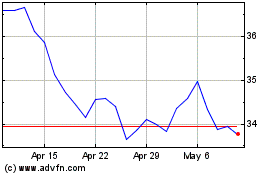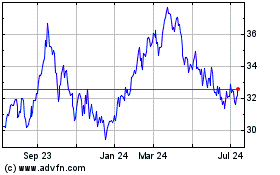Car Dealers Dangle Offers as Sales Slow -- WSJ
October 04 2016 - 3:04AM
Dow Jones News
Traffic cools after six years of steady growth; spending
increases on rebates and discounts
By Anne Steele and John D. Stoll
Light-vehicle sales sputtered in the U.S. last month despite
generous Labor Day holiday deals, with most of the market's biggest
sellers reporting declines from the prior September.
While the pace of sales remains historically strong, dealership
traffic is cooling after more than six years of steady growth.
General Motors Co., Ford Motor Co., Fiat Chrysler Automobiles NV
and Honda Motor Co. posted declines. Toyota Motor Corp. and Nissan
Motor Co. notched gains.
Retail demand has eased from a robust clip set in the final six
months of 2015. To keep North American factories running at full
steam and on pace for a record, auto makers have cranked up
spending on rebates and discounts and relied more heavily on fleet
customers, including rental-car companies, government agencies and
commercial clients.
Industry competitors spent nearly $400 more on incentives per
vehicle on average in September compared with a year earlier, and
incentives of $3,888 per-unit sold on average topped the prior
incentive-spending record for a single month set in December 2008,
according to J.D. Power. The last time incentives-per-unit were
this high, GM and Chrysler were appealing to Congress for bailouts
and sales across the industry were sinking.
The industry is in better shape seven years later, particularly
as buyers opt for heavier models that typically deliver bigger
margins. The incentive-spending increase, however, wipes out the
premium that auto makers are collecting as customers take advantage
of low gasoline prices and shift toward pricier trucks and
sport-utility vehicles.
In an interview, Nissan's U.S. sales chief, Judy Wheeler, said
there is room to run on the truck side of the business as vehicles
from big pickups to small crossovers remain hot. The Japanese brand
launched its October "Truck Month" advertising during American
football broadcasts last weekend. Ms. Wheeler credits a healthy
real-estate market and favorable economic conditions, in addition
to cheap fuel, for truck popularity.
In a conference call, Ford U.S. sales chief Mark LaNeve noted
"very aggressive" activity around Labor Day throughout the
industry. The average vehicle was marked down more than 10% during
the month, TrueCar Inc. estimates, which exceeds what it typically
has been and reflects ample inventory sitting on dealer lots.
Bill Fay, the chief of the Toyota brand in the U.S., said Monday
that some of the incentive spending comes as car companies slash
prices on 2016 model-year vehicles to make room for 2017 models. He
expects the industry volume to flirt with a record as customers
appear to be interested in making a deal.
"I would hope for a strong fourth quarter where there are a lot
of reasons for people to buy," he said. GM, for instance, is
offering to finance Chevrolets for 72 months with a 0% interest
rate through Oct. 10.
Brad Sowers, owner of Chevrolet dealerships near St. Louis and
Jefferson City, Mo., said: "We're feeling pretty good about the
finish to the year, as long as the election doesn't screw it up too
much."
Ford's Mr. LaNeve said retail sales, which strip out fleet
deliveries and reflect activity among individual consumers, fell 1%
compared with the same period a year earlier. He added that
September 2015 was among the best performances in the industry's
history, making it tough to top.
Including fleet sales, September volume slipped below 1.5
million for the first time since February, declining 0.5% compared
with the prior year, according to Autodata Corp. The firm said the
rate for seasonally adjusted annual sales was 17.76 million, among
the highest for 2016 but far behind the SAAR of 18 million notched
in September 2015.
GM's sales slipped 0.6% to 249,795 vehicles amid a continued
reduction in fleet sales and falling pickup sales; its
once-dominant market share is now below 17%. Ford, also pulling
back from fleet sales during the month, skidded 8.1% to 203,444
vehicles.
Fiat Chrysler edged down 0.9% to 192,883 vehicles as the Jeep
brand posted a 3% decline. Toyota's overall sales rose 1.5% to
197,260 vehicles amid solid truck sales, a trend that Nissan rode
to a 4.9% increase to 127,797 vehicle sales. Honda, meanwhile,
reported a 0.1% decline to 133,655 vehicles sold.
Mike Colias contributed to this article.
Write to Anne Steele at Anne.Steele@wsj.com and John D. Stoll at
john.stoll@wsj.com
(END) Dow Jones Newswires
October 04, 2016 02:49 ET (06:49 GMT)
Copyright (c) 2016 Dow Jones & Company, Inc.
Honda Motor (NYSE:HMC)
Historical Stock Chart
From Mar 2024 to Apr 2024

Honda Motor (NYSE:HMC)
Historical Stock Chart
From Apr 2023 to Apr 2024
